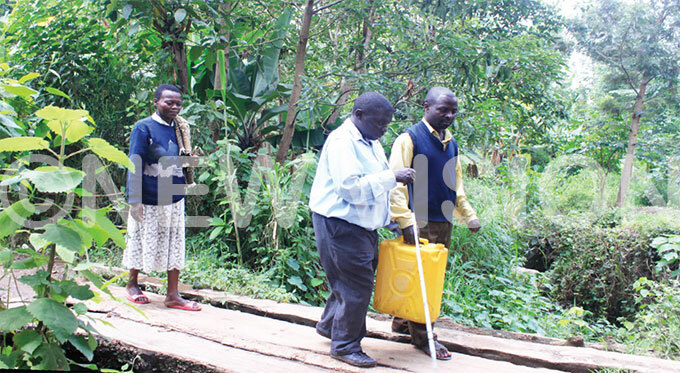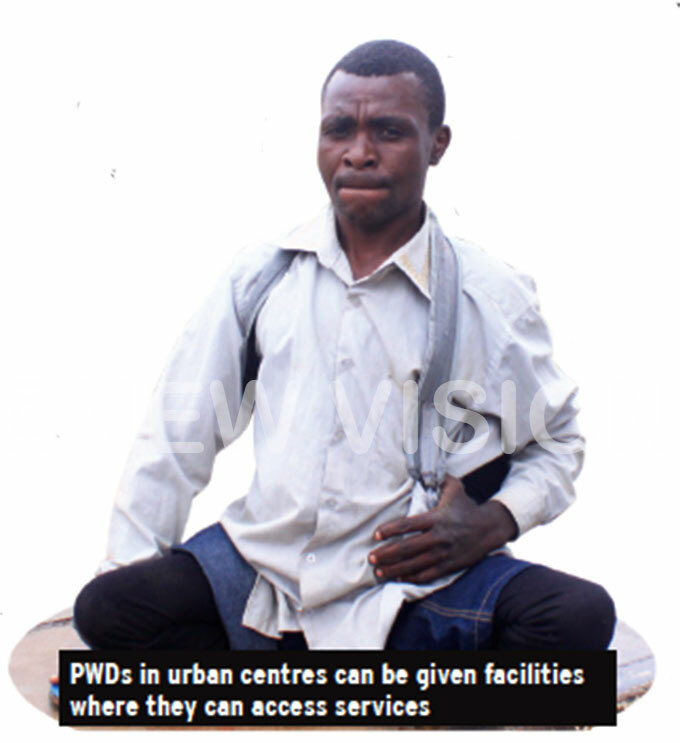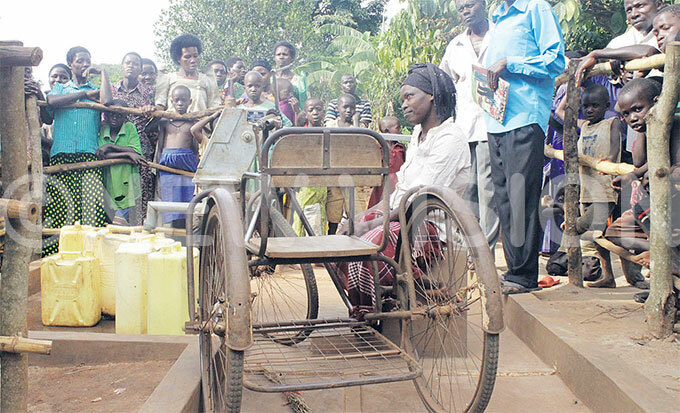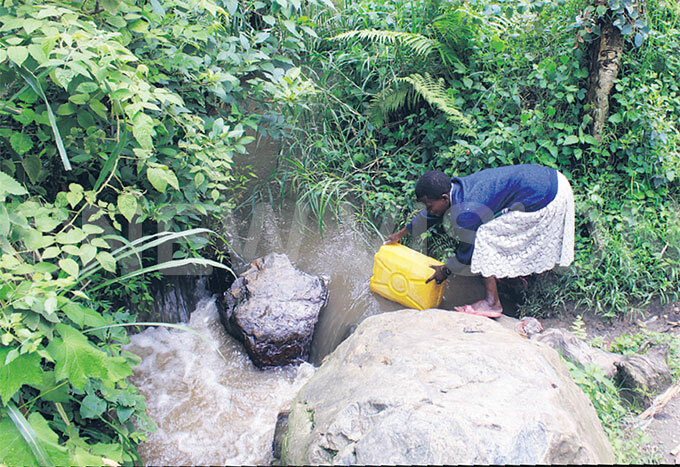How exclusion in sanitation programming has impaired PWDS more
Sep 05, 2017
According to the 2014 Uganda Population and Housing Census report, 4,096,477 (12.5%) of persons had at least one form of disability. This is too considerable a number of people to be ignored and left out in national social service programming.

The sad story
"When I have diarrhoea, it is best that I spend the days andnights nearer to the latrine so I can be able to quickly roll to ease myself. Short of that, I would never make it to the latrine in time."
Such is the story of Naome Sababu, a 30-year-old woman who has lived almost all her life with impairment in both her arms and legs. Her only mode of motion is by dragging herself by the buttocks. She suffered a measles attack when she was nine months old and has been paralysed.
When I arrived at her home, which is approximately one mile up the Rwenzori Mountains, I found her seated by the veranda of her mud-and-wattle house; helplessly looking at her sevenyear- old nephew, Benjamin Kato.
Kato, too is paraplegic and was soundly resting in a pool of goat excreta. This sight of the helpless boy in such a dirty environment shocked me so much that I had to excuse myself from my guide for a while as I gathered the courage to return and probe how these two impaired residents of Kibagha-B, Nyakitokoli, Karangura subcounty, Burahya county, in Kabarole district are managing to get by in such deprivation. Karangura is located about 16km from Fort Portal town, 10km off Bundibugyo Road.
The villages in Karangura sub-county are far-fl ung areas bordering and in the middle of the Rwenzori Mountains, where families commute long distances of 2-3km in search of clean water.
A recent annual assessment and community visit done by Water Charity, a nongovernment organization discovered that out of the eight schools in and around the Rwenzori Mountains, none has a nearby water source.
The children in these schools drink dirty water from faraway rivers. This poses a risk of contracting waterborne diseases such as diarrhoea, typhoid and cholera by school-going children.
But for children like Benjamin Kato of Karangura sub-county in Kabarole district, who cannot go to school because he is paraplegic, the impairment. The family was told that he got the problem as a result of a delayed delivery process, which his twin sister was lucky to survive. She is now studying in P.1 at a school down the mountain.
Naome Sababu, 30, also a resident of Karangua sub-county, relies on young children like Kato's sister to fetch for her water. "If the children are not around, I have to wait until they are back. Going to the latrine, I have to drag myself by the buttocks at a," she says in a tone that hardly hides her pain. The latrine she uses in used by about seven other members of the family, including children who defecate and urinate around the pit.
But, Kato and Sababu's anguish is just, but a small representation of what several more persons living with disabilities (PWDs) around the country go through to access water and sanitation services. Many argue that they have been left out and only cling by a thread of hope that the situation could change for the better someday.

According to the 2014 Uganda Population and Housing Census report, 4,096,477 (12.5%) of persons had at least one form of disability. This is too considerable a number of people to be ignored and left out in national social service programming.
Lawrence Kagenda, 14, a resident of a neighbouring village in Karangura, says the Government has neglected people like him in various programmes, including sanitation. When I met him, he was being pushed by his friends from school on his wheelchair, perhaps going home to have lunch.
"I find it a challenge accessing water or the latrine in instances where there is no one to help me," he laments.
Asked how he goes to the latrine, Kagenda says he moves on his knees, which in most cases leaves them swollen and very painful.
The distance from his home and the nearest water source is about 200m and he says accessing the source on his wheelchair is troublesome. He survives on the mercy of fellow children who fetch water for him.
At school (Kazingo SDA Primary School), he uses teachers' latrines because they appear cleaner since they have a concrete slab.
And for Evelyn Nyakaisiki, who has a hearing impairment, the inability to have enough money to pay for safe water at a nearby tap stand has remained her biggest challenge to accessing safe clean water.
A tap stand was constructed in her village, but she still has failed to access the clean water because she is required to pay a monthly maintenance fee of sh2,000, which she cannot afford.
"We are told that if we cannot pay that money, then we should not use the tap water," she says. Nyakaisiki has since stopped using the tap water and risks her life by fetching muddy water from the nearby river Mpanga. Most people in this village have also resorted to using the unsafe river water.
Similar situations
Taking a look at the situation in urban centres, one would expect that life is a little better for the PWDs, but living in such areas also comes with its challenges.
For Happy Simburiregye, a person with disability and resident of Fort Portal town, parting with money to access a sanitation facility is something he has vowed never to do.
He has been on the Fort Portal streets for about three years now, having moved from Bundibugyo.
Simburiregye says he faces a challenge accessing toilet services within the town because most of the facilities are built with steps (stairs) made of usually slippery tiles, yet he cannot climb them without help. To make matters worse, he has to part with some money to access the toilets yet he hardly earns a shilling.
"The truth is, I do not have money. But even when I have little,
I would rather spend it on getting what to eat than pay for toilet access. I, therefore, fi nd places where there are no people and ease myself or get a polythene bag," he admits.
This seems to contrast the 2016 Uganda Water and Environment Sector Performance Report, which indicates that in the 2015/16 fi nancial year, a total of 29 public toilets in 26 towns were constructed by the Water and Sanitation Development Facilities. The toilets, according to the report, have stances for both men and women, and each of the toilets has two stances for the PWDs, with one on the male side and the other on the female side. But maybe, Simburiregye's town is not among the 26.
Area leaders speak out
Kahuzo, who is also the LC3 chairperson of Karangura sub-county, says the area found in Burahya county, is a mountainous one and the residents get several challenges when it comes to water coverage. The area is not well-serviced with safe water and most people use thenearby River Mpanga.
When they need water, people in this area have to go deep in the valleys to draw water. "You can imagine how challenging such a terrain can be for someone who is visually impaired. I request the Government and NGOs to consider this sub-county and bring enough safe water sources closer to the people," he urges.
Kahuzo says what makes the situation worse is that when it rains, the valleys in which people fetch water are affected by mudslides, which contaminate the water. "It would be better if we were given gravity flow schemes or water harvesting tanks to enable bring water closer to the
people in the mountains," he adds.
When it comes to the latrine patterns, PWDs in this area have a huge challenge because the designs do not cater for them.
Inability to fetch water
Joseph Baguma (visually-impaired) is the councillor for PWDs in Karangura subcounty and also serves as the chairperson of the visually impaired in Kabarole district.
According to him, access to water, sanitation and hygiene (WASH) facilities in the area is a huge challenge for the PWDs. He says there are about 100 PWDs in Karangura alone.
He says most of the PWDs he interacts with say they cannot fetch water for themselves. "Some tell me that when they go to fetch water from a water source, the able-bodied persons insult and sometimes assault them, telling them to go away from the water source because they are not supposed to fetch water there. This is demeaning," he says.
Baguma adds: "This makes them feel they are not valued members of society.
What makes matters worse is that the water sources are not enough and most of the few available ones are far away from residences of these PWDs."
He gives an example of a tap stand near his home that is meant to serve more than 30 households. "When I want to fetch water from there, I have to get someone to go fetch it for me or guide me there. But not many visually impaired people have such social support mechanisms.
This leaves majority of the kind under the mercy of good-hearted people, who might not be there every day," he says.

On issues concerning latrine access, Baguma says the designs of latrines in the area do not put into consideration the needs of PWDs.
"The minimum standard latrine that a PWD can use is one that has a ramp, but in this area, I have not been told of any.
And that only caters for those with arms, but what then can a person with no arms do to hold onto the ramps?" he wonders. Baguma says PWDs in this community are still stigmatised and this has forced them to hold back whenever they are called upon to participate in developmental activities.
"Therefore, as PWDs, we have many challenges. As a leader, I am required to move through the entire sub-county looking to help other people like me, but I have limited resources, including lack of transport means. More so, many of the villages are hard to reach because they are in the mountains. This makes it very difficult for me to mobilise them," he says.
What should be done?
Baguma says sensitisation of PWDs and the rest of the communities on how to care for them should be done. "The water should also be brought closer to homes where PWDs are identifi ed to be living.
This will improve accessibility," he says. For places like Kirangira village, in Buyende district, simple technology has seen the construction of inclusive boreholes.
These have improved access to clean and safe water, but more so are user-friendly for the elderly and PWDs. Constructed by Plan International-Uganda, the boreholes have a ramp that allows people in wheelchairs to access them.
In addition, there is a concrete base built purposely for them to sit as they pump water.
Mary Magoba, 27, a PWD in Kirangira village, says on several occasions; before the borehole was constructed, she would go to bed without showering if at all there was no Good Samaritan to fetch for her a jerrycan of water.
She says she previously was unable to climb the hills leading to the village spring well. But today, she can afford to ride her wheelchair to the borehole and get water.
Judging from the experiences above and many more that are left undocumented, living with any kind of disability comes with limitations. These pose a huge challenge in the search for comfortable living.
So what then can you make of a situation where one who already has the limitations caused by disability also has to endure the pains of lacking essential facilitators of comfortable living like proper hygiene? Something should be done.
What sector players are doing
Stephen Birungi, working with Health through Water and Sanitation programme (HEWASA), an organisation under Fort Portal Catholic Diocese, says in as far as equity and inclusion of PWDs in water and sanitation programming is concerned, more concentration has been put on the sanitation aspect than water.
"In sanitation, we design special stances for people with disabilities when we are constructing latrines at the institution level such as schools and health centres," he says. Birungi explains that in terms of water, although not much has been done,
HEWASA is employing models aimed at bringing water closer to the people; including those with impairment. This has been made mainly through gravity flow water systems.
"With this system, we use tap stands, where even PWDs can be able to draw water since they are easier to open unlike boreholes that may require one to be strong," he says.
But disability being a complex concept that includes those that have visual, hearing or neurological impairments and cannot be able to move by themselves to the tap stands, Birungi reveals that a software component has been developed.
 Inclusive safe water sources must be set up closer to PWDs to boost their self-reliance
Inclusive safe water sources must be set up closer to PWDs to boost their self-reliance
It aims at making sure that such people have support from the people they live with. "The software component focuses majorly on the sensitisation of the communities, specifically targeting PWDs and their relatives.
This is aimed at making sure they are able to give support to their persons with impairments," Birungi says. "He adds: "We have also come up with a consortium of partner organisations, which will mainly focus on advocacy for community empowerment of marginalised categories and in this case, PWDs are at the core."
He says many times, these have been overlooked, especially in technology designs.
"Under this programme, we are trying to give them a voice such that they can be listened to and the duty bearers come up with technologies that can take care of PWDs," Birungi adds.
Monica Komucunguzi, also working with
HEWASA, says several interventions in sanitation have been made to promote social inclusion.
"We have a case in Bufunjo, Kyenjojo district, where a visually impaired man did not have a latrine. He was using the bush to ease himself. We worked with community members to construct for him a latrine and a handwashing facility," she says.
Komucunguzi adds: "We have also employed a mechanism of creating stone pathways to the latrine so a blind person can find their way to the latrine even without a guide. Using their walking sticks, they are trained that if they identify where the stones are, they can slowly move along the stone path to get to the latrine by themselves."
 A woman with a hearing impairment fetching water from River Mpanga
A woman with a hearing impairment fetching water from River Mpanga
She also states that in some other cases, ropes are used along the path to the latrine so that such a person can hold onto that rope to guide them to the latrine.
"More so, in places like Kyalusozi, there are albinos who for long have been marginalized by their communities.
We make sure that when we are holding WASH meetings in the community, they participate and their views heard. This has made them feel part of the community," she states.
We make sure that when we are holding WASH meetings in the community, they participate and their views heard. This has made them feel part of the community," she states.
